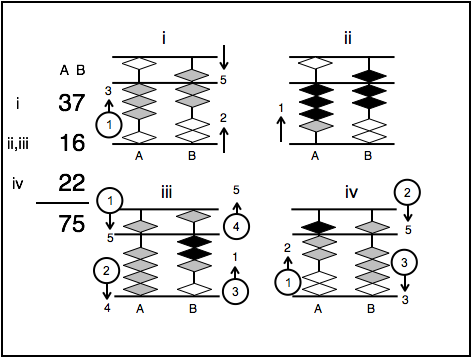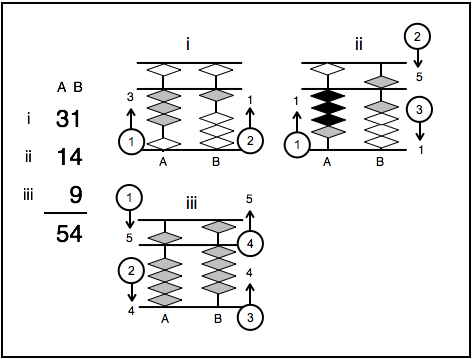Abacus Math Program – Lesson 13 – Forward Double Five
To this point in our abacus skill training we have introduced all of the basic bead movements required to perform any addition or subtraction problem. To take on problems with larger number sizes, i.e. more digits per number, we will learn how to repeatedly use the basic bead movements over and over again to handle larger numbers. Here in Lesson 13 we introduce the concept of the “Double Five” first in the forward direction for addition. In Lesson 14 Reverse Double Five we will show the Double Five in the reverse direction for subtraction. The Double Five movement will require students to employ two 5 pair movements to execute a single 10 pair addition movement. As we saw in Lesson 11 and Lesson 12 with 5/10 pair combinations to complete a 10 pair movement we needed to subtract the 10 pair in the form of a 5 pair. Now we take this one step further where we need to complete the 10 pair addition movement using two 5 pair movements, one 5 pair is needed to add 1 to the next rod left and another 5 pair is needed to subtract the 10 pair on the target rod. The resulting two 5 pairs needed is why we call it the “Double Five” movement. In the examples below we will examine the Forward (addition) Double Fives.
The important thing to note is that this approach of repeatedly using the same basic bead movements over and over again in combination is a general approach to problem solving on the abacus. The idea that we are breaking down complex problems into simple basic bead movements is why abacus math is so powerful and can be generalized to any arithmetic problem. For those deeply familiar with the 4 standard algorithms taught in most school math classes, the intent of each of these algorithms is to do exactly the same thing by breaking down complex problems into simple, easy to manage single digit problems.
In this first example we start off by adding 37 to the abacus adding 3 to rod A and 7 to rod B. Next we add 16 to 37 on the abacus. We will take a digit by digit approach working from left to right. Abacus users work problems from left to right instead of how we are traditionally taught working right to left. It is much more efficient to work from left to right because this is how we read numbers. It is also working from the most significant digit in each number to the least significant digit. Working left to right we start adding 16 to 37 by adding 1 to 3 on rod A. The interim sum is now 47. Next we add the 6 to 7 on rod B using the 10 pair addition rule. However this 10 pair addition will require the Forward Double Five. According to the 10 pair addition rule we first add 1 to 4 on rod A using a 5 pair movement by adding 5 and subtracting 4, the 5 pair complement of 1, on rod A leaving 5 on rod A. We complete the 10 pair addition by subtracting 4, the 10 pair complement of 6, from 7 on rod B again using a second 5 pair. We add 1, the 5 pair complement of 4, and subtract 5 leaving 3 on rod A. The interim sum is now 53 completing the Forward Double Five movement. Lastly we add 22 to 53 by first adding 2 to 5 on rod A leaving 7 on rod A. Then we add 2 to 3 on rod B using a 5 pair by adding 5 and subtracting 3, the 5 pair of 2, leaving 5 on rod B. The final answer is 75.

In this second example of Forward Double Fives we start by adding 31 to the abacus adding 3 to 0 on rod A and 1 to 0 on rod B. Next we add 14 to 31 by first adding 1 to 3 on rod A. Then add 4 to 1 on rod B using a 5 pair adding 5 and subtracting 1, the 5 pair complement of 4, leaving 5 on rod B. The interim sum is now 45. Lastly we add 9 to 45 by adding 9 to 5 on rod B. This will require the Forward Double Five bead movement. We add 9 to 5 using the 10 pair addition rule first adding 1 to 4 on rod A. Add 1 to 4 using a 5 pair adding 5 and subtracting 4, the 5 pair complement of 1, leaving 5 on rod A. Next we subtract 1, the 10 pair complement of 9, from 5 on rod B again using a 5 pair. Add 4, the 5 pair complement of 1, and subtract 5 leaving 4 on rod B. The final answer is 54.

Next up Lesson 14 Reverse Double Five.